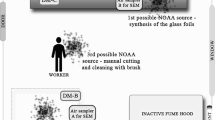This paper is devoted to a major area of concern and an approach for hygiene and toxicology studies allowing us to estimate the potential risk to workers from chemicals and to recommend protective measures aimed at preservation of health. We present tentative safe exposure levels in atmospheric air and maximum permissible concentrations in the workplace for a number of chemicals, obtained as a result of toxicology animal studies. We demonstrate the capabilities of a method for rapid assessment in vitro of the general acute toxicity on the AT-05 image analyzer.
Similar content being viewed by others
References
Z. A. Volkova, Gigiena i Sanitariya, No. 10, 22–27 (1972).
A. P. Dyban, V. S. Baranov, and I. M. Akimova, Arkhiv Anatomii, Gistologii, Émbriologii (Leningrad), 40,89 (1970).
I. V. Sanotskii and V. N. Fomenko, Long-Term Effects of Chemical Compounds on the Body [in Russian], Meditsina, Moscow (1979), pp. 56–58, 96–108.
I. V. Sanotskii, ed., Methods for Determining Toxicity and Risk of Chemicals [in Russian], Meditsina, Moscow (1970).
“Procedural guidelines for studies to validate health standards for hazardous substances in workplace air,” No. 2163-80 [in Russian], Minzdrav SSSR, Moscow (1980).
Health Standard GN 1.1.701-08, “Hygienic criteria for validation of the need for development of MPC (maximum permissible concentrations), TSEL (tentative safe exposure levels) or APL (tentative permissible levels) of hazardous substances in workplace air, atmospheric air in populated areas, and water in bodies of water,” Approved by Russian Gossanépidnadzor, 30 April 1998 [in Russian], Meditsina, Moscow (1998).
S. N. Golikov, I. V. Sanotskii, and L. A. Tiunov, General Mechanisms of Toxicity [in Russian], Meditsina, Leningrad (1986), pp. 54–109.
A. I. Strukov and V. V. Serov, Anatomic Pathology [in Russian], Meditsina, Moscow (1985), pp. 5–8.
Health Standard GN 2.2.5.1313-03, “Maximum permissible concentrations (MPC) for hazardous substances in workplace air,” Approved 27 April 2003 [in Russian], Moscow (2003).
“Procedural guidelines for establishing tentative safe exposure levels for hazardous substances in workplace air,” No. 4000–85, approved by USSR Minzdrav 04 November 1985.
V. E. Balashov, V. V. Bartenev et al., in: I. M. Trakhtenberg, general editor, Toxicology Assessment of Volatile Substances Released from Synthetic Materials, Zdorov’ya, Kiev (1968), pp. 54–108.
Health Standard GN 2.1.6.1339-03, “Tentative Safe Exposure Levels (TSEL) for Pollutants in Atmospheric Air of Populated Areas” [in Russian], Russian Minzdrav, Moscow (2003).
“Procedural Guidelines. Biological testing of products made from polymeric and other materials,” No. 1.1.037-95 [in Russian], Goskomsanépidnadzor, Moscow (1996).
“Resolution of the Customs Union Commission dated 28 May 2010,” No. 299.
Author information
Authors and Affiliations
Additional information
Translated from Khimicheskie Volokna, Vol. 43, No. 1, pp. 17–21, January-February, 2011.
Rights and permissions
About this article
Cite this article
Chudinskaya, T.A., Nikiforova, I.V., Smirnova, G.A. et al. Toxicology and hygiene assessment of production operations for synthetic fibers and products as a necessary aspect of occupational safety. Fibre Chem 43, 18–21 (2011). https://doi.org/10.1007/s10692-011-9302-7
Published:
Issue Date:
DOI: https://doi.org/10.1007/s10692-011-9302-7




